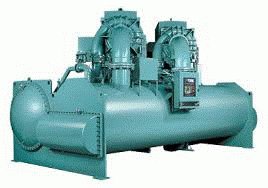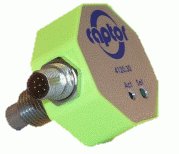Making Chilled Water Systems Reliable with the new 4120.30 Analog Flow/Temperature Sensor
03 Mar 16 Chilled water is commonly used in industrial processes such as aluminum
anodizing, mold cooling and plating applications as well as the vast
majority of large commercial buildings. Any good energy conservation
strategy should include monitoring the system efficiency but there are
additional benefits in doing so. When one of these machines goes down
it’s like giving your budget the ole one two. Not only is production
down… the cost of the repair itself can be a wallet buster.
Many might believe that a great many catastrophic failures occur without
warning, but this is simply not true. The fact is that the vast
majority of breakdowns provide ample warning if you know what to look
for. The simple fact is that long before almost every significant
breakdown, there will be a glaring change in system efficiency. So not
only is it a good idea to know how efficient your chilled water systems
are for energy saving reasons, experience shows that by acting on
efficiency change, breakdowns will almost never happen.
So how does one measure efficiency of a chilled water system?
Speaking in terms of Imperial units the efficiency of a chilled water
system is normally measured in KW/Ton. Basically, this is a measure of
how much electrical power is needed to produce a certain amount of
cooling.
To calculate tonnage:
Tons = 12,000 / 500 * GPM * TD
Where:
TD is the temperature of the water entering and leaving the chiller evaporator
GPM is the gallons per minute flow rate going through the chiller
12,000 and 500 are constants in the equation
Divide the result of this calculation into the kilowatts the chiller is consuming and you get KW/Ton efficiency.
Most chilled water systems will automatically unload as needed, which
means that the KW/Ton will change when the load on the chilled water
system changes. Therefore, it is important to benchmark how many KW/Ton
the chilled water produces at varying loads under normal operation. This
will not only help you understand how much your chiller costs to
operate it will also give you the tools for an early warning sign of
impending failure.
What your machine probably has and does not have to track efficiency
Based on the calculations, the first thing needed to determine
efficiency is the amount of power (in this case KW the chilled water
system is using at any given time). Most modern chillers come with this
reading available from the factory and it can be clearly viewed on the
systems control panel. The other item that comes with your chilled water
system is either a supply or return water sensor. This is needed in
order to control the system’s capacity. Typically, smaller chilled water
systems have a return temperature sensor while larger ones have a
supply water sensor. Getting that information out of the systems control
panel and into a data log is something we know a great deal about and
can help you with.
This leaves two sensors that are not typically supplied by the chilled
water system manufacturer which are either the return temperature sensor
(on larger systems) or the supply water temperature sensor (on smaller
systems) and the GPM flow rate.
The ideal solution is the 4120.30 analog flow sensor
It combines both flow and temperature into a very economical compact
easy to install unit. If your chiller has a supply water temperature
install the 4120.30 in the return or vice versa.
Each sensor offers operators two choices of communication, both (2)
4-20mA outputs (one for flow the other for temperature) and Modbus RTU
protocol. The accuracy on the flow side is +-2% over range while
temperature accuracy is less than +-0.5°. What is also really unique
about the 4120.30 analog sensor is that it can be field calibrated in
circumstances where large lengths of straight pipe do not exist.



